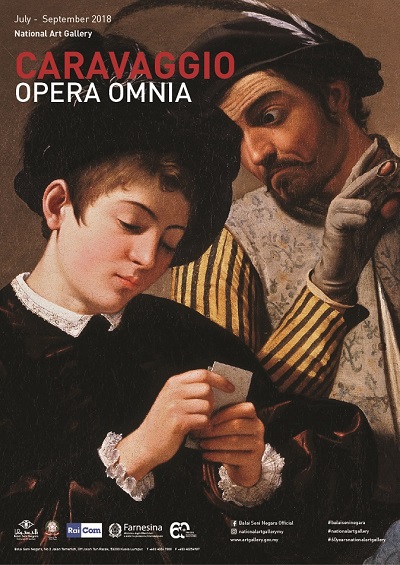
Caravaggio Opera Omnia is a tour exhibition supported by the Italian Ministry of Foreign Affair and International Cooperation and RAI, the Italian national broadcasting company. It is now showcasing in National Art Gallery of Malaysia. This exhibition gathers 34 replicas of Caravaggio’s classic masterpieces. The original artworks housed in different galleries and church such as Uffizi Gallery, Florence, Louvre Museum, Paris and Metropolitan Museum of Art, New York. Hence, this exhibition offers visitors the chance to explore and learn Caravaggio’s art journey in this one-stop art hub.
Caravaggio was one of the most prominent Italian artists during 16th to early 17th century. His family was originally from a small town named Caravaggio, hence it became his nickname. Caravaggio’s real name is Michelangelo Merisi. His artworks are well recognised for his naturalistic style of depiction, as described by the curator, Prof. Antonio Paolucci, Caravaggio paintings were well-known as he portrayed the visible truth, his works are “palettes of true and simple colour, that rendered visible by light “.
This exhibition displays his replicas in a chronological order from year 1593 and goes through 1610. It includes the artworks of his early period such as Young Sick Bacchus (1593), The Musician (1594-1595), Boy Bitten by a Lizzard (1595). Following them are those significant commissioned works such as The Calling of Matthew and The Martyrdom of Saint Matthew (1599-1600) and The Conversion of Saint Paul (1600-1601). the Conversion of St. Paul on the Way to Damascus (1601) and Madonna and Child with St. Anne (1604-1606) were among the impeccable commissioned paintings in terms of technical skills, yet they were also very controversial pieces at that time due to reason of “desacralisation” or vulgar representation. Although Caravaggio gained fame by his talent, his life was so much in turmoil. He fled from Rome in 1606 to escape a capital punishment. He left some artworks in Naples (The Flagellation of Christ, 1607 – 1610, The Martyrdom of St. Ursula, 1610) and Malta (Portrait of Alof de Wignacourt with his Page, 1608 and The Beheading of Saint John the Baptist, 1608). Caravaggio painted his self-portrait on the beheaded head of David with the Head of Goliath, 1609-1610, this one last piece also marked the end of the artist’s tragic life.
The use of contrast lighting or chiaroscuro / tenebrism is the key technique of Caravaggio’s paintings. By installing light box behind each translucent print, the chiaroscuro effects of these artworks are even more outstandingly presented in this exhibition. Hence, the subjects and objects of the paintings are vivid and real with the aims of lighting adjustment and high definition printing quality. The positioning of spotlight and light box are right at their places as there is no any projected shadow blocks the artworks even the viewer stand in front of them / under the spotlight. Meanwhile, the yellowish spotlights do not affect the colours of art prints as there are light box behind them. Moreover, all reproductions are printed to the same size of original artworks. Some of them are more than 300cm of height. Hence, the replicas are eye-catching and impactful when standing in front of the artworks. Since the thematic colour of this exhibition is black, it creates a solemn and mysterious ambience around the gallery. Shedding light onto the dark space, it enhances the visitors’ themselves the experience of dramatic illumination (tenebrism). Tenebrism or chiaroscuro is pictorial approach that believed to be invented by Caravaggio.
High definition digital quality clearly presents the detail delineation as shown in the original art pieces. In the painting Cardsharps (1595-1596), The visitors can have a closer look at the delineation of the subjects’ facial expressions, trivial details such as patterns on clothes or wrinkles beneath their clothes.
Besides that, visible flaws on the original pieces such as scratches and cracked paint are duplicated too in these printed artworks. For instance, in The Adoration of the Shepherds (1608-1609), the painting is reproduced without refining the scratches from its original piece. It aims to generate the audiences’ visual experience that attached to their original paintings.
The exhibition is good for most of the part, nevertheless, there are some spaces of improvement. Firstly, there are descriptions and write-up beside each artwork for viewers to have a better understanding onto each art piece. However, the texts are too small and placed slightly lower than the standard eye level. Furthermore, the lighting is too dim for appropriate reading conditions. Hence, installation of audio recording is strongly recommended. Dealing with this issue, the gallery has printed the art book / catalogue of Caravaggio Opera Omnia that included all these artwork descriptions.
The exhibition has kindled the visitors to learn more regarding the Caravaggio’s art. It is currently taking place in National Art Gallery of Malaysia and will be ended at 5th of September 2018.


